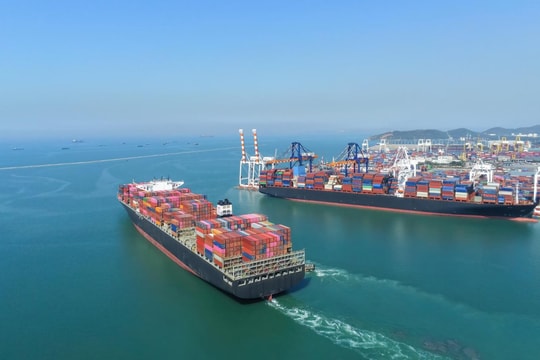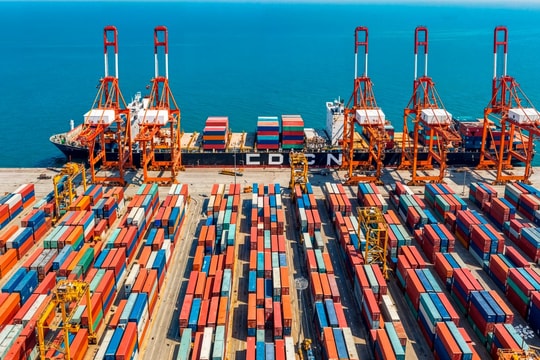
Facing this challenge, digital transformation in the supply chain is not merely a technological trend but a strategic breakthrough. It enables businesses, from production to distribution, to escape passivity, build long-term competitive advantages, and create sustainable operational value.
Strategic Digitalization of the Supply Chain: It Begins with Leadership Vision
Technology is not the starting point; strategic vision is. This transformation demands engagement from the top management level, with a proactive and long-term approach. Instead of seeing digitalization as the responsibility of the IT department, leading companies have embedded digital transformation into their overarching strategic vision, identifying it as a core element of organizational capability.
Here, three foundational pillars shape the strategic plan: people—where analytical skills, collaboration, and a spirit of continuous improvement must be ignited at every level; data—which fuels every algorithm and needs to be standardized and integrated from warehouses to retail points; and technology selection—guided by the criteria of compatibility and value creation rather than blindly chasing trends.
Digital transformation does not start with technology—it starts with strategic thinking and leadership capable of overcoming operational inertia.
The lack of a comprehensive vision is the main reason why many digital projects stall or fail, even with significant investment. Every new platform needs clear goals, measurable outcomes, and system-wide commitment—from top-level managers to frontline operational staff.
Implementation Process: From Pilot to System-Wide Rollout
No matter how sound the strategy, it will remain theoretical if not effectively implemented. Here, the principle of "pilot – evaluate – scale" plays a vital role. Many successful businesses begin digital transformation at high-impact points with clearly measurable outcomes, such as distribution centers, key transport routes, or demand planning processes.
Piloting allows companies to test solutions in real-life environments, adjust operational models, and establish appropriate performance metrics. Once verified results are in—like reduced delivery times, decreased inventory, or lower logistics costs—businesses have a solid foundation to expand the implementation across the supply chain and establish new standardized processes alongside technology.
Starting with small but high-leverage areas is the most practical strategy for actualizing digital transformation of the supply chain with low risk and quick effectiveness.
More importantly, this journey must be accompanied by a professional change management team, guiding the organization through cultural and psychological barriers associated with change.

Core Technologies Powering Digital Transformation
If strategy and process are the roadmap, technology is the vehicle driving the supply chain into the future. Among them, three key technologies stand out: IoT, AI, and Blockchain.
IoT devices monitor the real-time status of goods—from vehicle locations to refrigerated container temperatures. This is particularly critical in industries like food and pharmaceuticals, where product quality depends directly on storage conditions. IoT not only delivers data but enables rapid response to risks such as equipment failures, unexpected weather, or traffic congestion.
AI and predictive analytics are bringing groundbreaking improvements in forecasting market demand, optimizing inventory, and increasing accuracy in production planning. No longer dependent on Excel or intuition, today’s supply chain managers make decisions based on analysis of millions of real-time data points.
Blockchain, combined with Digital Twin models, plays a crucial role in traceability, enhancing transparency, and preventing fraud across global supply chains. Especially in sensitive sectors like fashion, organic food, or pharmaceuticals, blockchain allows consumers, distributors, and suppliers to share a single, immutable source of truth.
Challenges and How to Overcome Them
Despite its potential, the path to digital transformation is fraught with challenges. High upfront costs—especially for small and medium-sized enterprises—are a major hurdle. Added to this are legacy systems that don't integrate well with new solutions, creating "data blind spots" that reduce overall effectiveness.
Another significant obstacle is the shortage of digitally skilled professionals—those who can manage data, operate systems, and make informed decisions on digital platforms. This forces businesses to consider internal development strategies, retraining current staff, hiring experts, and partnering with specialized tech startups.
Gartner expert Mr. Alex D’Avello noted at the 2025 SCM Symposium that “Digital supply chain transformation is no longer a ‘tactic’—it’s a matter of survival for businesses over the next five years. It’s the way to maintain stable operations, boost competitiveness, and respond flexibly to global disruptions.”
Digital transformation of the supply chain is a long journey requiring strategic thinking, consistency in execution, and continuous adaptability to technological evolution and market demands. Where businesses start, how they proceed, and with whom they partner are decisive factors in the success or failure of digitalization.
We believe success in digital transformation does not come from chasing trends or pouring in massive investments. Instead, it lies in understanding clear objectives, selecting suitable technologies, and—most importantly—having the organizational capability to convert that technology into operational value. The more complex the supply chain, the more flexibility it requires, and digital transformation provides the foundation to turn that complexity into a real competitive edge.
Businesses don’t need to digitalize everything—they need to digitalize the right components, at the right time, with the right technologies to unlock leverage for the whole system.













.png)







.png)